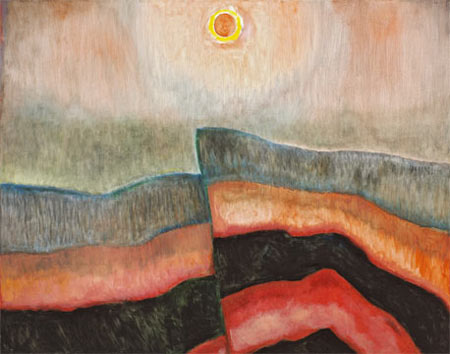
Frederick Wight (1902-1986) first established himself as a fixture in the California art scene not as a painter, but during a two-decade tenure as a museum curator and director of the UCLA Art Gallery. Located on the North Campus well before the development of the Hammer Museum, Wight championed the careers of artists who had yet to receive national attention including Charles Sheeler, John Marin, Arthur Dove, Alexander Archipenko, Jacques Lipschitz, and Stanton MacDonald-Wright. From 1953 to 1973 Wight was not only instrumental in shaping the careers of artists, but in creating a thriving foundation at the UCLA Art Gallery with the creation of the Franklin D. Murphy Sculpture Garden, which showcased the works of Henry Moore, Jean Arp, Joan Miro, Henri Matisse, Alexander Calder, and David Smith.
It was not until his retirement in his seventies that Wight was able to fully commit to his painting practice, which celebrated the California landscape, Joshua Tree, and the coastline of the Pacific. From a formal standpoint, in these landscapes he explored the subtleties of oil paint. “Radiant Skies - California Paintings by Frederick Wight” celebrates the artist’s contributions to American and California painting following his retirement from administration. In barely over a decade he produced about 250 major paintings. Wight signals a rare instance of having served for a leading California art institution, thus sacrificing the creation of his own work, and then assumed a creative mantle for which he became widely celebrated. Thus Wight is a California institution in his own right.
Also active as a writer, in his first novel, “South” (1935) which received critical claim, Wight analyzes the Western landscapes that foreshadow the luminosity and kinetic energy of the California skies that would later characterize his body of work: “Outside the window the sun fumbled its way upward behind a wilderness of pine trees. The sky overhead … was string with the most infinite spider-webbing of cloud; such a pale misty white the blue behind it had gone to silver. Yet for all its infinity it had a near tactile quality, like the mist-divided strata of the landscape. It was characteristic of the things in the South,… to reach you by some auxiliary sense, even its sky.”
In “Desert Morning (Morning Hours II)” the sun splinters like shards of reflective glass igniting a celestial spark in the vast open sky, with colors like Wight had described: “pale misty white, the blue behind it had gone to silver.” The morning sun dwarfs a mountain range that diminishes in the distance, while Wight’s paint handling renders a two dimensional surface into a multi-dimensional scene familiar yet still fantastical to those of who have witnessed such exquisite California moments.
While works such as “End of Day” and “Moon and Sea” explore the symbiotic relationship between the vast Pacific Ocean and the setting sun, “Tame Palms” recalls a scene that is quintessentially California. As if inspired by a view in a convertible, two palm trees separated by fine gold brush strokes emanate warmth and cast a glow off the canvas. There seems to be a visual tug of war between the full palm tree in view in the lower corner and the second palm tree, which appears to grow out of the canvas. “Tame Palms” represents a common thread present in Wight’s body of work, scenes that are familiar but transformed through the subtle handling of paint, manipulation of colors that echo the surreal palette found in nature, and the celebration of the state that he radically transformed through his vision in and out of the museum.
Published courtesy of ArtSceneCal ©2011
